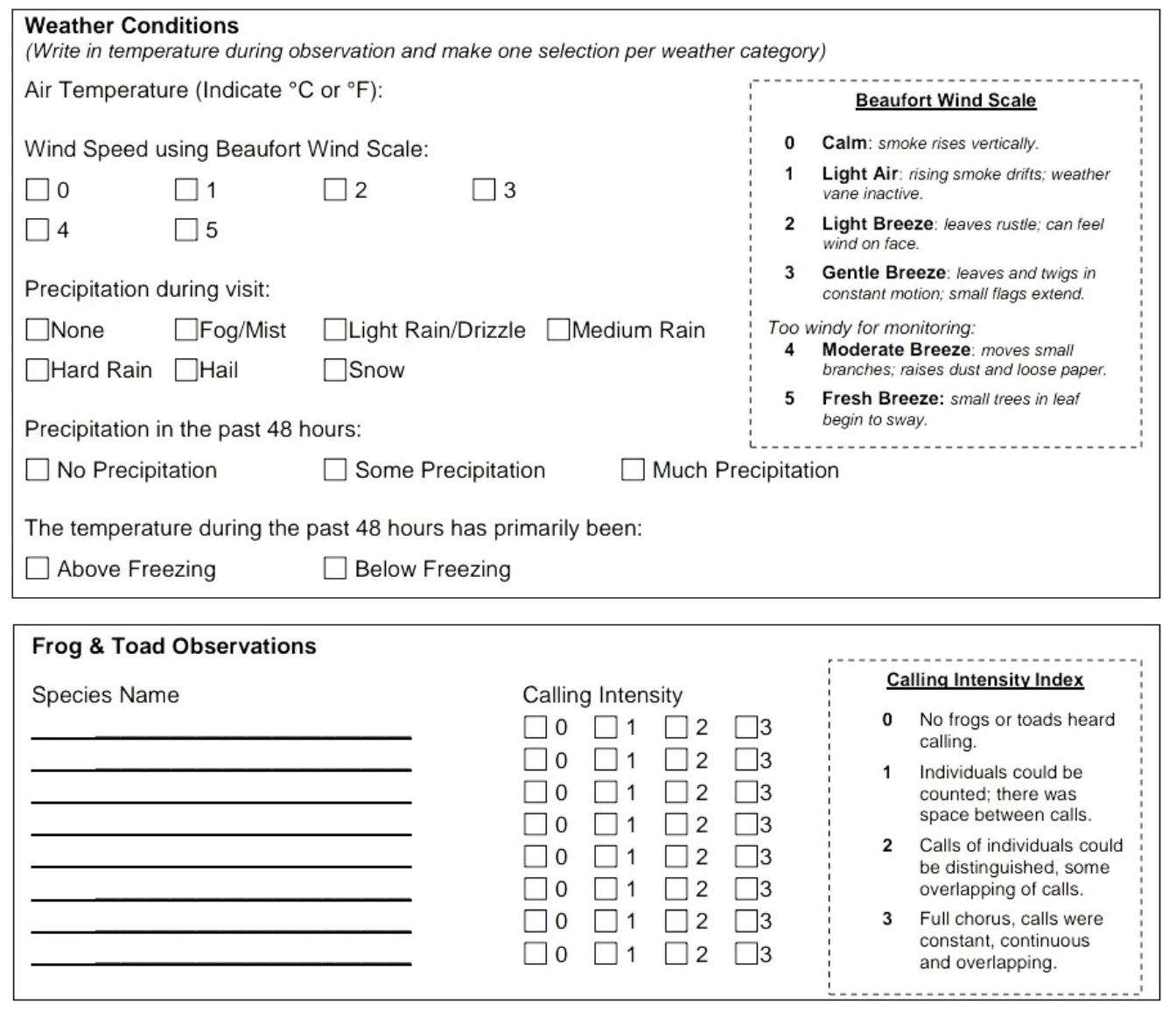citizen science
Surveying Sounds of the Season
Science Scope—May/June 2023 (Volume 46, Issue 5)
By Jill Nugent
Throughout the spring and summer, sounds from nature seem to surround us. Bird songs and insect sounds (such as those made by crickets) accompany the growing season. A symphony of sounds can be heard in wetland areas where amphibians (such as frogs and toads) fill the evenings with their calls as they search for mates during the breeding season. The calls are unique to each species, so monitoring frog and toad calls can be an easy (and nonintrusive) way to assess local amphibian populations.
Amphibians serve as indicators of local environmental quality, and many amphibian species are experiencing population declines in the modern world. Nearly a third of amphibian species worldwide are facing significant declines where extinction is a threat. There is still much to be known about the unique challenges faced by amphibian populations. FrogWatch USA is a citizen science project that began in 1998 to involve the public in monitoring frogs and toads in local wetland areas to better understand amphibian conservation questions. As of 2022, the Akron Zoo serves as the home for this national citizen science program (see “Project home”).
The FrogWatch USA program is organized into a network of chapters (see “Project list of chapters”). Training is provided through the local chapters and is also available online. Data from this large-scale citizen science program provides insights into amphibian conservation questions and challenges. By reporting calls of local frogs and toads, students will contribute to important science that is addressing questions relating to change over time; the occurrence, abundance, and diversity of frog and toad species; and the presence (or absence) of rare and invasive species.
Project goal: Amphibian conservation and wetland habitat awareness and education
Your task: Report the seasonal calls of local frogs and toads
Science discipline: Life and Environmental Science
To get started in FrogWatch USA, you’ll want to engage in the project training, which is available through local chapters and is also available online (see “Project volunteer page”). The online training lasts roughly three to four hours. During the training, you will learn about project protocol, as well as the types of frogs and amphibians that you may encounter; you will also receive training to help identify frog and toad species by their unique calls. In addition to online training materials, the project also maintains a helpful online video education collection (see “Project video collection”).
The FrogWatch USA monitoring season runs February through August. Once a wetland site is identified and selected, the fieldwork involves collecting data on the local weather conditions as well as the amphibian calls heard during the survey along with their intensity (see Figure 1 and “Project link to datasheet”). Once collected, data can be uploaded into the project’s online database.

A snapshot of the FrogWatch USA datasheet.
Materials you will need:
- access to wetland site
- FrogWatch USA datasheet (see “Project link to datasheet”)
- clipboard
- pencil
- flashlight
- thermometer (to measure air temperature)
- watch or timer
- cell phone
- audio recording device, rain gear, plastic to cover data sheet in case of rain (optional)
The BSCS Science Learning’s FieldScope platform offers additional science learning applications for FrogWatch USA (see “Resources from FieldScope”). The FieldScope platform, along with its Invitations to Inquiry activities, provides data literacy connections to the citizen science project. Available resources include educator guides, student handouts, multiday classroom investigations, and more. With FieldScope, students have an opportunity to work with FrogWatch USA data, visualize data, analyze maps, and interpret graphs.
Two of FieldScope’s Invitations to Inquiry lessons are specifically designed to complement the FrogWatch USA project: Frog Eat Frog World and Frog Symphony. In Frog Eat Frog World, students use maps and data to take a deep dive into learning more about the American Bullfrog and its impacts to wetland ecosystems. In Frog Symphony, students use maps and graphs to help predict the best time to hear a chorus of frogs. The collective resources and classroom activities provide meaningful connections to the FrogWatch USA program.
Participation in FrogWatch USA provides students with authentic science engagement experiences. The large-scale, long-term project, combined with the FieldScope platform’s resources, provides learners with a unique opportunity to contribute to real-world science, derive meaning from data, and make discoveries.
FrogWatch USA at a glance
When: February–August
How: Visit the project volunteer page to get involved in the FrogWatch USA program (see “Project volunteer page”). FrogWatch USA training is available from local chapters and is also available online.
Where: United States, local wetland site
Time needed: Variable, such as monitoring a wetland site once weekly
Special equipment needed: None
Cost: No cost to participate
Contact for more information: frogwatch@akronzoo.org
Safety: As with any science lab, classroom, or field activity, always ensure that you are following recommended safety practices; for more information on safety in the science classroom, visit .
Helpful Project Links
Project home—https://www.akronzoo.org/frogwatch
Project link on SciStarter—https://scistarter.org/frogwatch-usatm
Project link to datasheet—https://tinyurl.com/yyrk4vrd
Project list of FrogWatch chapters—https://bit.ly/3JF8B7h
Project video collection—https://bit.ly/3K2uz5m
Project volunteer page—https://www.akronzoo.org/frogwatch-usa-volunteers
Resources from FieldScope
FrogWatch USA on FieldScope—https://frogwatch.fieldscope.org/
Frog eat frog world—https://bscs.org/inquiry/frog-eat-frog-world/
Frog symphony—https://bscs.org/inquiry/frog-symphony/
Jill Nugent (jillfnugent@gmail.com) teaches science online; engages educators in citizen science experiences for the classroom, schoolyard, and beyond; and serves on the SciStarter Team. Follow SciStarter on Twitter: @SciStarter.
This column is the result of a partnership between SciStarter and the National Science Teaching Association. For more information about SciStarter and other citizen science projects, please visit www.scistarter.org.
Citizen Science Labs Life Science Middle School


